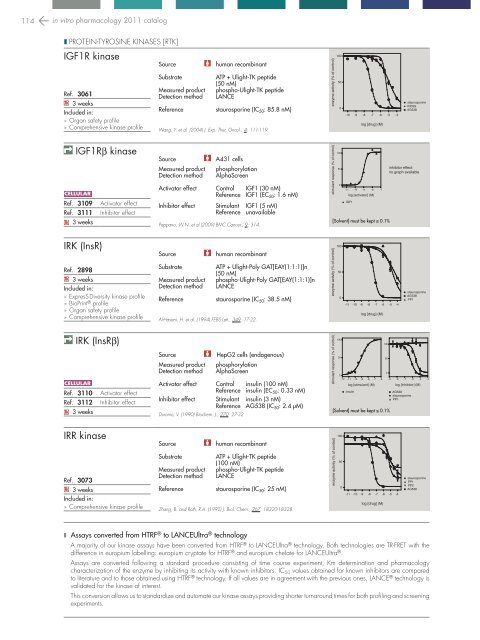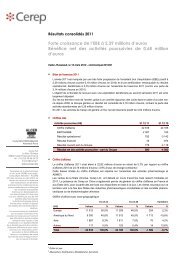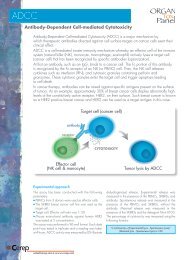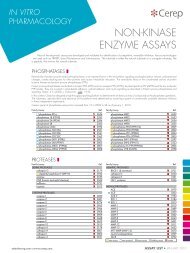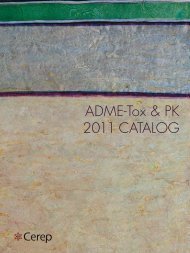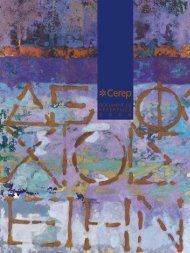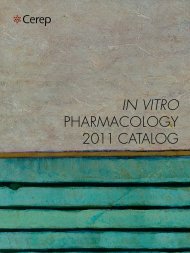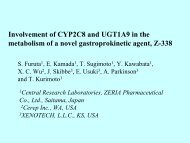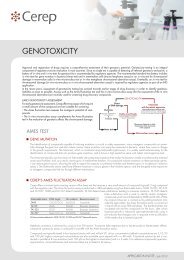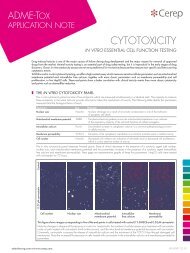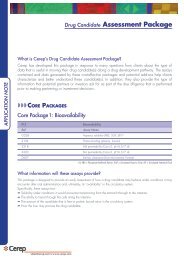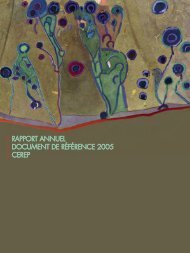in vitro PHARMACOLOGY 2011 CATALOG - Cerep
in vitro PHARMACOLOGY 2011 CATALOG - Cerep
in vitro PHARMACOLOGY 2011 CATALOG - Cerep
You also want an ePaper? Increase the reach of your titles
YUMPU automatically turns print PDFs into web optimized ePapers that Google loves.
114 <strong>in</strong> <strong>vitro</strong> pharmacology <strong>2011</strong> catalog<br />
❚ prote<strong>in</strong>-tyros<strong>in</strong>e k<strong>in</strong>ases [Rtk]<br />
IGF1R k<strong>in</strong>ase<br />
Ref. 3061<br />
Q 3 weeks<br />
Included <strong>in</strong>:<br />
Organ safety profile<br />
Comprehensive k<strong>in</strong>ase profile<br />
Source<br />
Substrate<br />
Measured product<br />
Detection method<br />
Reference<br />
human recomb<strong>in</strong>ant<br />
ATP + Ulight-TK peptide<br />
(50 nM)<br />
phospho-Ulight-TK peptide<br />
LANCE<br />
staurospor<strong>in</strong>e (IC 50 : 85.8 nM)<br />
Wang, Y. et al. (2004) J. Exp. Ther. Oncol., 4: 111-119.<br />
<br />
<br />
<br />
<br />
<br />
<br />
<br />
<br />
<br />
IGF1Rb k<strong>in</strong>ase<br />
cellul ar<br />
Ref. 3109 Activator effect<br />
Ref. 3111 Inhibitor effect<br />
Q 3 weeks<br />
Source<br />
Measured product<br />
Detection method<br />
A431 cells<br />
phosphorylation<br />
AlphaScreen<br />
Activator effect Control IGF1 (30 nM)<br />
Reference IGF1 (EC 50 : 1.6 nM)<br />
Inhibitor effect Stimulant IGF1 (5 nM)<br />
Reference unavailable<br />
Pappano, W.N. et al.(2009) BMC Cancer., 9: 314.<br />
<br />
<br />
<br />
<br />
<br />
<br />
<br />
<br />
<br />
<br />
<br />
<br />
<br />
<br />
<br />
<br />
<br />
[Solvent] must be kept 0.1%<br />
<br />
IRK (InsR)<br />
Ref. 2898<br />
Q 3 weeks<br />
Included <strong>in</strong>:<br />
ExpresS Diversity k<strong>in</strong>ase profile<br />
BioPr<strong>in</strong>t ® profile<br />
Organ safety profile<br />
Comprehensive k<strong>in</strong>ase profile<br />
Source<br />
human recomb<strong>in</strong>ant<br />
Substrate<br />
ATP + Ulight-Poly GAT[EAY(1:1:1)]n<br />
(50 nM)<br />
Measured product phospho-Ulight-Poly GAT[EAY(1:1:1)]n<br />
Detection method LANCE<br />
Reference<br />
staurospor<strong>in</strong>e (IC 50 : 38.5 nM)<br />
Al-Hasani, H. et al. (1994) FEBS Lett., 349: 17-22.<br />
<br />
<br />
<br />
<br />
<br />
<br />
<br />
<br />
<br />
<br />
<br />
<br />
<br />
<br />
<br />
<br />
<br />
IRK (InsRb)<br />
cellul ar<br />
Ref. 3110 Activator effect<br />
Ref. 3112 Inhibitor effect<br />
Q 3 weeks<br />
Source<br />
Measured product<br />
Detection method<br />
HepG2 cells (endogenous)<br />
phosphorylation<br />
AlphaScreen<br />
Activator effect Control <strong>in</strong>sul<strong>in</strong> (100 nM)<br />
Reference <strong>in</strong>sul<strong>in</strong> (EC 50 : 0.33 nM)<br />
Inhibitor effect Stimulant <strong>in</strong>sul<strong>in</strong> (3 nM)<br />
Reference AG538 (IC 50 : 2.4 µM)<br />
Duronio, V. (1990) Biochem. J., 270: 27-32<br />
<br />
<br />
<br />
<br />
<br />
<br />
<br />
<br />
<br />
<br />
<br />
<br />
<br />
<br />
<br />
<br />
<br />
<br />
<br />
<br />
<br />
[Solvent] must be kept 0.1%<br />
<br />
<br />
IRR k<strong>in</strong>ase<br />
Ref. 3073<br />
Q 3 weeks<br />
Included <strong>in</strong>:<br />
Comprehensive k<strong>in</strong>ase profile<br />
Source<br />
human recomb<strong>in</strong>ant<br />
Substrate<br />
ATP + Ulight-TK peptide<br />
(100 nM)<br />
Measured product phospho-Ulight-TK peptide<br />
Detection method LANCE<br />
Reference<br />
staurospor<strong>in</strong>e (IC 50 : 25 nM)<br />
Zhang, B. and Roth, R.A. (1992) J. Biol. Chem., 267: 18320-18328.<br />
<br />
<br />
<br />
<br />
<br />
<br />
<br />
<br />
<br />
<br />
<br />
<br />
<br />
<br />
<br />
<br />
<br />
<br />
<br />
❚ Assays converted from HTRF ® to LANCEUltra ® technology<br />
<br />
A majority of our k<strong>in</strong>ase assays have been converted from HTRF ® to LANCEUltra ® technology. Both technologies<br />
<br />
are<br />
TR-FRET <br />
with the<br />
difference <strong>in</strong> europium labell<strong>in</strong>g: europium cryptate for HTRF ® and europium chelate for LANCEUltra ® .<br />
<br />
Assays are converted follow<strong>in</strong>g a standard procedure consist<strong>in</strong>g of time course experiment, Km determ<strong>in</strong>ation and pharmacology<br />
characterization of the enzyme by <strong>in</strong>hibit<strong>in</strong>g its activity with known <strong>in</strong>hibitors. IC 50 values obta<strong>in</strong>ed for known <strong>in</strong>hibitors are compared<br />
<br />
to literature and to those obta<strong>in</strong>ed us<strong>in</strong>g HTRF ® technology. If all values are <strong>in</strong> agreement with the previous ones, LANCE ® technology is<br />
<br />
validated for the k<strong>in</strong>ase of <strong>in</strong>terest.<br />
This conversion allows us to standardize and automate our k<strong>in</strong>ase assays provid<strong>in</strong>g shorter turnaround times<br />
<br />
for<br />
<br />
both<br />
<br />
profil<strong>in</strong>g<br />
<br />
and<br />
<br />
screen<strong>in</strong>g<br />
experiments.


